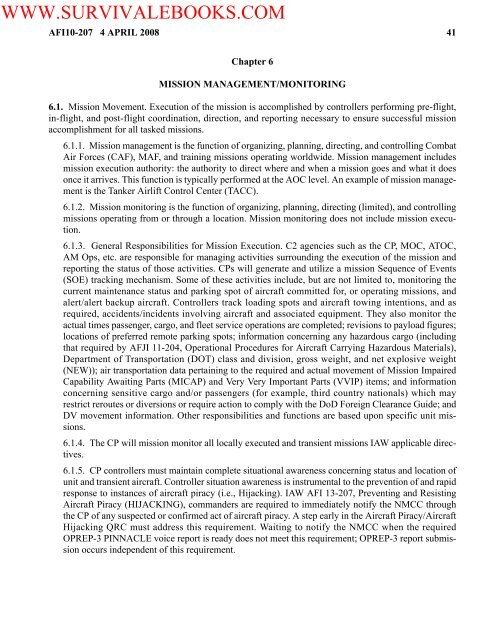2004 US Air Force OPERATIONAL REPORTING ... - Survival Books
2004 US Air Force OPERATIONAL REPORTING ... - Survival Books
2004 US Air Force OPERATIONAL REPORTING ... - Survival Books
You also want an ePaper? Increase the reach of your titles
YUMPU automatically turns print PDFs into web optimized ePapers that Google loves.
WWW.SURVIVALEBOOKS.COMAFI10-207 4 APRIL 2008 41Chapter 6MISSION MANAGEMENT/MONITORING6.1. Mission Movement. Execution of the mission is accomplished by controllers performing pre-flight,in-flight, and post-flight coordination, direction, and reporting necessary to ensure successful missionaccomplishment for all tasked missions.6.1.1. Mission management is the function of organizing, planning, directing, and controlling Combat<strong>Air</strong> <strong>Force</strong>s (CAF), MAF, and training missions operating worldwide. Mission management includesmission execution authority: the authority to direct where and when a mission goes and what it doesonce it arrives. This function is typically performed at the AOC level. An example of mission managementis the Tanker <strong>Air</strong>lift Control Center (TACC).6.1.2. Mission monitoring is the function of organizing, planning, directing (limited), and controllingmissions operating from or through a location. Mission monitoring does not include mission execution.6.1.3. General Responsibilities for Mission Execution. C2 agencies such as the CP, MOC, ATOC,AM Ops, etc. are responsible for managing activities surrounding the execution of the mission andreporting the status of those activities. CPs will generate and utilize a mission Sequence of Events(SOE) tracking mechanism. Some of these activities include, but are not limited to, monitoring thecurrent maintenance status and parking spot of aircraft committed for, or operating missions, andalert/alert backup aircraft. Controllers track loading spots and aircraft towing intentions, and asrequired, accidents/incidents involving aircraft and associated equipment. They also monitor theactual times passenger, cargo, and fleet service operations are completed; revisions to payload figures;locations of preferred remote parking spots; information concerning any hazardous cargo (includingthat required by AFJI 11-204, Operational Procedures for <strong>Air</strong>craft Carrying Hazardous Materials),Department of Transportation (DOT) class and division, gross weight, and net explosive weight(NEW)); air transportation data pertaining to the required and actual movement of Mission ImpairedCapability Awaiting Parts (MICAP) and Very Very Important Parts (VVIP) items; and informationconcerning sensitive cargo and/or passengers (for example, third country nationals) which mayrestrict reroutes or diversions or require action to comply with the DoD Foreign Clearance Guide; andDV movement information. Other responsibilities and functions are based upon specific unit missions.6.1.4. The CP will mission monitor all locally executed and transient missions IAW applicable directives.6.1.5. CP controllers must maintain complete situational awareness concerning status and location ofunit and transient aircraft. Controller situation awareness is instrumental to the prevention of and rapidresponse to instances of aircraft piracy (i.e., Hijacking). IAW AFI 13-207, Preventing and Resisting<strong>Air</strong>craft Piracy (HIJACKING), commanders are required to immediately notify the NMCC throughthe CP of any suspected or confirmed act of aircraft piracy. A step early in the <strong>Air</strong>craft Piracy/<strong>Air</strong>craftHijacking QRC must address this requirement. Waiting to notify the NMCC when the requiredOPREP-3 PINNACLE voice report is ready does not meet this requirement; OPREP-3 report submissionoccurs independent of this requirement.
















